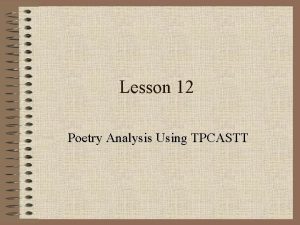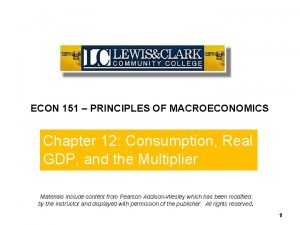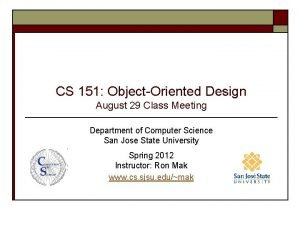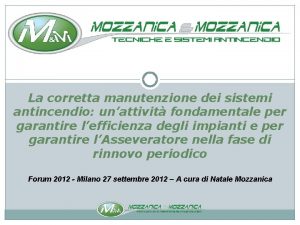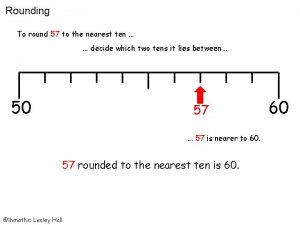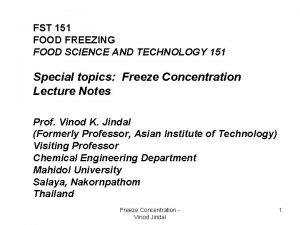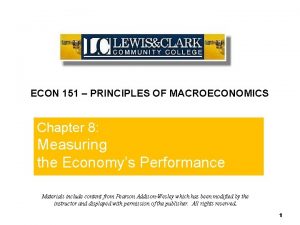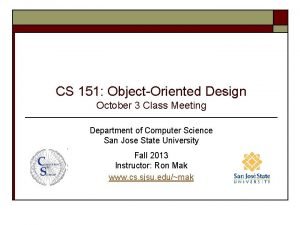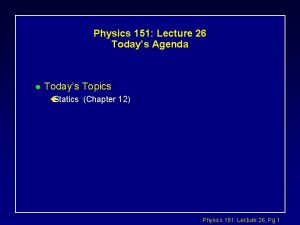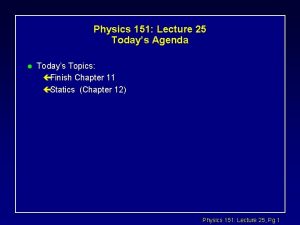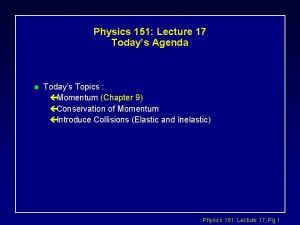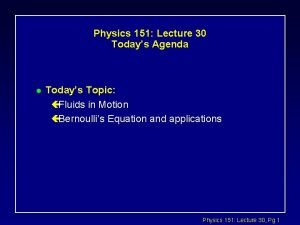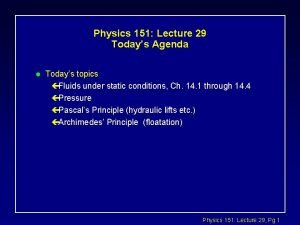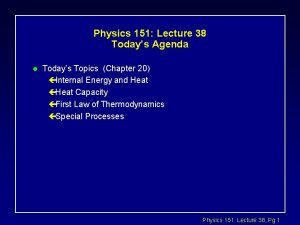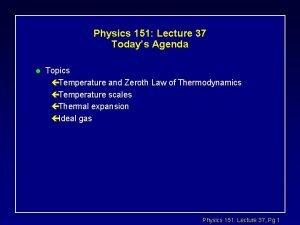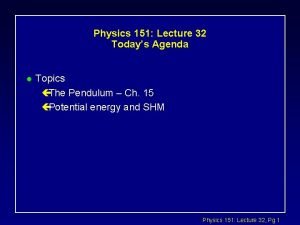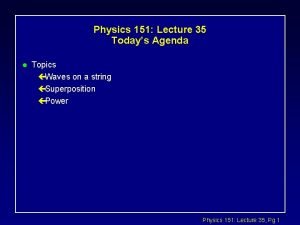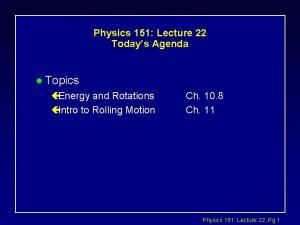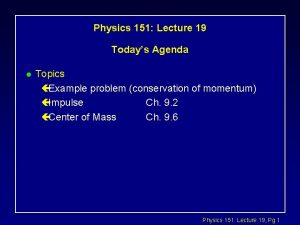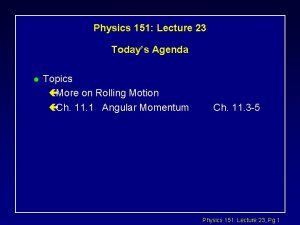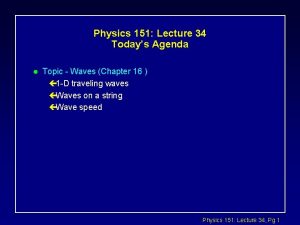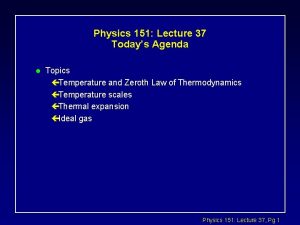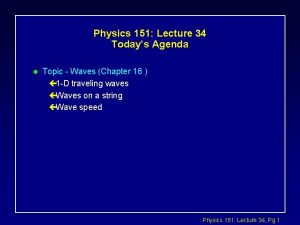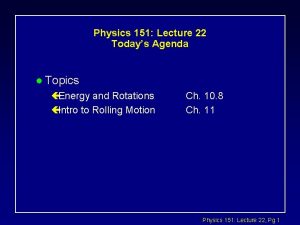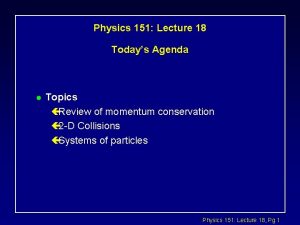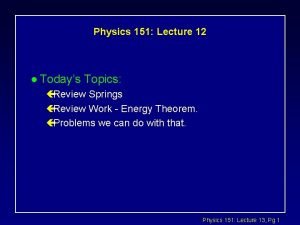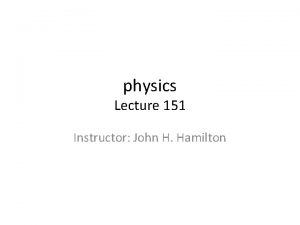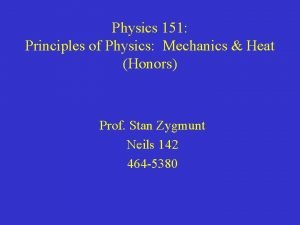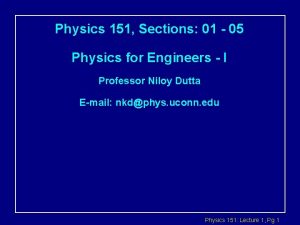Physics 151 Lecture 31 Todays Agenda l Todays





























- Slides: 29

Physics 151: Lecture 31 Today’s Agenda l Today’s Topics ç Simple Harmonic Motion – masses on springs (Ch 15. 1 -2) ç Energy of the SHO – Ch. 15. 3 ç Pendula. Physics 151: Lecture 31, Pg 1

See text: 15. 1 -2 l Simple Harmonic Motion (SHM) We know that if we stretch a spring with a mass on the end and let it go the mass will oscillate back and forth (if there is no friction). k l This oscillation is called Simple Harmonic Motion, and is actually very easy to understand. . . k k m m m Physics 151: Lecture 31, Pg 2

See text: 15. 1 -2 SHM Dynamics l l At any given instant we know that F = ma must be true. But in this case F = -kx k a m and ma = l So: -kx = ma = x a differential equation for x(t) ! Physics 151: Lecture 31, Pg 3

See text: 15. 1 -2 SHM Dynamics. . . define Try the solution x = Acos( t) this works, so it must be a solution ! Physics 151: Lecture 31, Pg 4

See text: 15. 1 -2 SHM Dynamics. . . But wait a minute. . . what does angular frequency have to do with moving back & forth in a straight line ? ? l y = R cos ( t) y 1 1 2 3 x 4 6 5 0 -1 1 2 3 4 6 5 Physics 151: Lecture 31, Pg 5

See text: 15. 1 -2 SHM Solution l We just showed that (which came from F=ma) has the solution x = Acos( t). l This is not a unique solution, though. x = Asin( t) is also a solution. l The most general solution is a linear combination of these two solutions! x = Bsin( t)+ Ccos( t) l This is equivalent to: x = A cos( t+ ) where is called a phase Physics 151: Lecture 31, Pg 6

See text: 15. 1 -2 SHM Solution. . . l l Drawing of Acos( t ) A = amplitude of oscillation T = 2 / A A Physics 151: Lecture 31, Pg 7

See text: 15. 1 -2 SHM Solution. . . l Drawing of Acos( t + ) Physics 151: Lecture 31, Pg 8

See text: 15. 1 -2 SHM Solution. . . l Drawing of Acos( t - /2) A = Asin( t) ! Physics 151: Lecture 31, Pg 9

See text: 15. 2 Velocity and Acceleration x(t) = Acos( t + ) v(t) = - Asin( t + ) a(t) = - 2 Acos( t + ) Position: Velocity: Acceleration: by taking derivatives, since: x. MAX = A v. MAX = A a. MAX = 2 A k m 0 x Physics 151: Lecture 31, Pg 10

Lecture 31, Act 1 Simple Harmonic Motion l A mass oscillates up & down on a spring. It’s position as a function of time is shown below. At which of the points shown does the mass have positive velocity and negative acceleration ? y(t) (a) (c) t (b) Physics 151: Lecture 31, Pg 11

Lecture 31, Act 1 Solution l The slope of y(t) tells us the sign of the velocity since l y(t) and a(t) have the opposite sign since a(t) = - 2 y(t) a<0 v<0 y(t) a<0 v>0 (a) (c) t (b) a>0 v>0 The answer is (c). Physics 151: Lecture 31, Pg 12

See text: 15. 2 Example l A mass m = 2 kg on a spring oscillates with amplitude A = 10 cm. At t=0 its speed is maximum, and is v = +2 m/s. ç What is the angular frequency of oscillation ? ç What is the spring constant k ? v. MAX = Also: k = m 2 So k = (2 kg) x (20 s -1) 2 = 800 kg/s 2 = 800 N/m k m x Physics 151: Lecture 31, Pg 13

See text: 15. 2 Initial Conditions Use “initial conditions” to determine phase ! Suppose we are told x(0) = 0 , and x is initially increasing (i. e. v(0) = positive): x(t) = Acos( t + ) v(t) = - Asin( t + ) a(t) = - 2 Acos( t + ) So = - /2 k cos sin m 0 x Physics 151: Lecture 31, Pg 14

Lecture 31, Act 2 Initial Conditions l A mass hanging from a vertical spring is lifted a distance d above equilibrium and released at t = 0. Which of the following describe its velocity and acceleration as a function of time (upwards is positive y direction): (a) v(t) = vmax sin( t) (b) v(t) = vmax cos( t) (c) v(t) = - vmax sin( t) a(t) = amax cos( t) k a(t) = -amax cos( t) t=0 a(t) = -amax cos( t) y m d 0 (both vmax and amax are positive numbers) Physics 151: Lecture 31, Pg 15

See text: 15. 2 Energy of the Spring-Mass System We know enough to discuss the mechanical energy of the oscillating mass on a spring. Remember, x(t) = Acos( t + ) v(t) = - Asin( t + ) a(t) = - 2 Acos( t + ) Kinetic energy is always K = 1/2 mv 2 K = 1/2 m (- Asin( t + ))2 We also know what the potential energy of a spring is, U = 1/2 k x 2 U = 1/2 k (Acos( t + ))2 Physics 151: Lecture 31, Pg 16

See text: 15. 3 Energy of the Spring-Mass System Add to get E = K + U 1/2 m ( A)2 sin 2( t + ) + 1/2 k (Acos( t + ))2 Remember that so, E = 1/2 k. A 2 sin 2( t + ) + 1/2 k. A 2 cos 2( t + ) = 1/2 k. A 2 ( sin 2( t + ) + cos 2( t + )) = 1/2 k. A 2 E = 1/2 k. A 2 U~cos 2 K~sin 2 Physics 151: Lecture 31, Pg 17

See text: 15. 1 to 15. 3 SHM So Far l The most general solution is x = Acos( t + ) where A = amplitude = frequency = phase constant l For a mass on a spring l ç The frequency does not depend on the amplitude !!! ç We will see that this is true of all simple harmonic motion ! The oscillation occurs around the equilibrium point where the force is zero! Physics 151: Lecture 31, Pg 18

See text: 15. 4 The Simple Pendulum l A pendulum is made by suspending a mass m at the end of a string of length L. Find the frequency of oscillation for small displacements. z L m mg Physics 151: Lecture 31, Pg 19

Aside: sin and cos for small l A Taylor expansion of sin and cos about = 0 gives: and So for <<1, and Physics 151: Lecture 31, Pg 20

See text: 15 -5 l The Simple Pendulum. . . Recall that the torque due to gravity about the rotation (z) axis is = -mgd. d = Lsin L for small so = -mg L l z But = I I = m. L 2 L where m d Differential equation for simple harmonic motion ! mg = 0 cos( t + ) Physics 151: Lecture 31, Pg 21

Lecture 31, Act 3 Simple Harmonic Motion l l You are sitting on a swing. A friend gives you a small push and you start swinging back & forth with period T 1. Suppose you were standing on the swing rather than sitting. When given a small push you start swinging back & forth with period T 2. ç Which of the following is true: (a) T 1 = T 2 (b) T 1 > T 2 (c) T 1 < T 2 Physics 151: Lecture 31, Pg 22

Lecture 31, Act 3 Solution Standing up raises the CM of the swing, making it shorter ! L 2 L 1 T 1 Since L 1 > L 2 we see that T 1 > T 2 (b) Physics 151: Lecture 31, Pg 23

Lecture 31, Act 4 Simple Harmonic Motion l Two clocks with basic timekeeping mechanism consist of 1) a mass on a string and 2) a simple pendulum. Both have a period of 1 s on Earth. When taken to the moon which one of the statements below is correct ? a) b) c) d) e) the periods of both is unchanged. one of them has a period shorter than 1 s. the pendulum has a period longer than 1 s. the mass-spring system has a period longer than 1 s. both c) and d) are true. Physics 151: Lecture 31, Pg 24

See text: 15. 4 The Rod Pendulum l A pendulum is made by suspending a thin rod of length L and mass M at one end. Find the frequency of oscillation for small displacements. z x. CM L mg Physics 151: Lecture 31, Pg 25

See text: 15. 4 The Rod Pendulum. . . The torque about the rotation (z) axis is l = -mgd = -mg{L/2}sin -mg{L/2} for small z In this case l l d So = I becomes I L/2 x. CM where L d mg Physics 151: Lecture 31, Pg 26

Lecture 31, Act 4 Period l What length do we make the simple pendulum so that it has the same period as the rod pendulum? LS (a) (b) LR (c) Physics 151: Lecture 31, Pg 27

See text: 15 -5 Lecture 31, Act 4 Solution LS LR b) S = R if Physics 151: Lecture 31, Pg 28

Recap of today’s lecture l Simple Harmonic Motion, ç Example, block on a spring ç Energy of SHM ç Pendula are just like block/spring Physics 151: Lecture 31, Pg 29
 Todays agenda
Todays agenda 01:640:244 lecture notes - lecture 15: plat, idah, farad
01:640:244 lecture notes - lecture 15: plat, idah, farad Agenda sistemica y agenda institucional
Agenda sistemica y agenda institucional The equilibrium level of real gdp
The equilibrium level of real gdp 118/151
118/151 Cs 151 sjsu
Cs 151 sjsu Apsc 151
Apsc 151 Hino 151
Hino 151 Scia antincendio esempio
Scia antincendio esempio Business information management uci
Business information management uci Round 57
Round 57 Freeze concentration
Freeze concentration 1,151,725 bytes
1,151,725 bytes Econ 151
Econ 151 Econ 151
Econ 151 Tổng kết vốn từ 151
Tổng kết vốn từ 151 Chemistry 151 final exam
Chemistry 151 final exam Mcb 151
Mcb 151 Csc
Csc Sjsu cs 151
Sjsu cs 151 Immurel
Immurel Model-netics
Model-netics Physics 101 lecture notes pdf
Physics 101 lecture notes pdf Classical mechanics
Classical mechanics Waves physics notes pdf
Waves physics notes pdf What is a harmonic wave in physics
What is a harmonic wave in physics Atmospheric physics lecture notes
Atmospheric physics lecture notes Physics 101 lecture 1
Physics 101 lecture 1 Why does it happen
Why does it happen University physics with modern physics fifteenth edition
University physics with modern physics fifteenth edition
